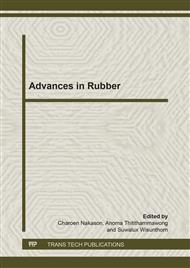p.93
p.97
p.101
p.105
p.109
p.113
p.117
p.122
p.127
Mixing Methods Influencing on Properties of Epoxidized Natural Rubber/Polypropylene Thermoplastic Vulcanizates
Abstract:
Epoxidized natural rubber (ENR)/Polypropylene (PP) thermoplastic vulcanizates were prepared by melt mixing method in an internal mixer. Influences of different mixing methods for incorporation of processing oil into the TPVs on tensile and dynamic mechanical properties of the TPVs and crystallinity of the PP were investigated. Results show that distribution of processing oil in the ENR/PP TPV is important due to the processing oil can promote and in the same time can interrupt an improvement in elastomeric properties of the TPV. Incorporation of processing oil into the ENR phase by preparation of oil extended ENR (the mixing method 1) before mixing with the PP was the better way to produce the TPV. It promoted the TPV with superior tensile and dynamic mechanical properties than the TPVs prepared from the mixing method 2 and 3 in which the processing oil was directly added into the PP phase. Furthermore, the TPV from the mixing method 1 had less effect of processing oil on the PP crystallization.
Info:
Periodical:
Pages:
109-112
Citation:
Online since:
November 2013
Authors:
Price:
Сopyright:
© 2014 Trans Tech Publications Ltd. All Rights Reserved
Share:
Citation:


